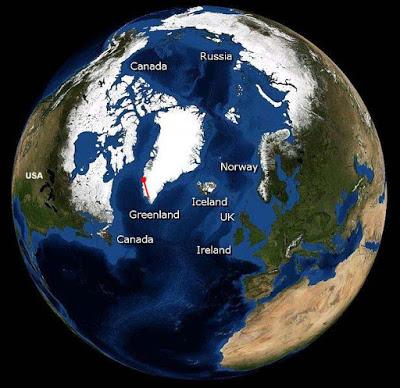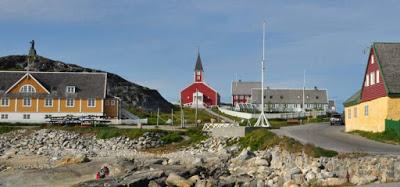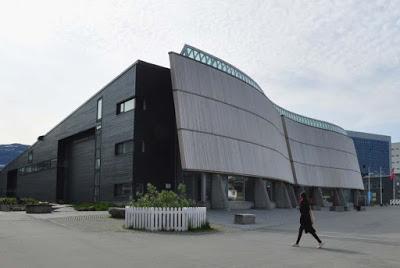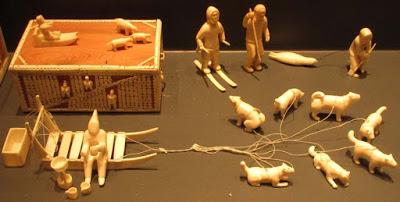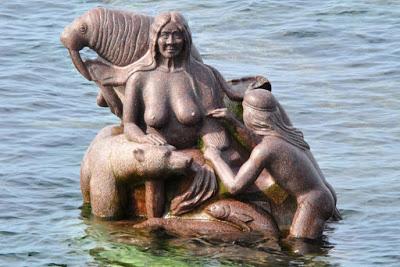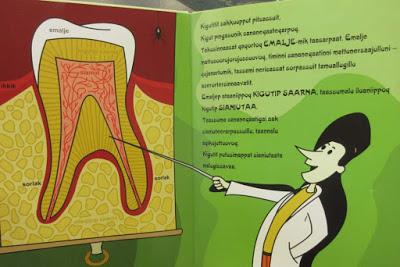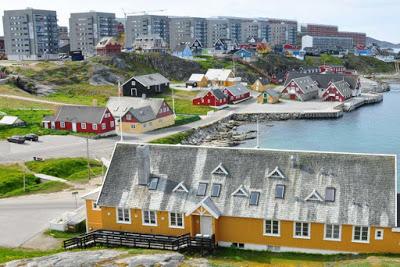
Nuuk, the capital of Greenland, has been growing since Danish colonial times
My friend and fellow children’s book author Caroline Hatton and her husband Bill visited Greenland in July 2019. She took all the photosin this post.
Flying from Narsarsuaq to Nuuk. Image courtesy of NASA, with red added.
After three days in Narsarsuaq enjoying a rich variety of experiences, we flew 1 hour 15 minutes up the west coast to Nuuk(pronounced nuke), the capital.
Can you find a heart-shaped lake?
Airplane seats are not assigned on domestic Air Greenland flights. We picked right-window seats, hoping to see the fringes of the Greenland Ice Sheet. Sights were awesome beyond words, with countless glaciers, snow caps, lakes, and braided rivers. Any lake size, shape, and shade of blue I can dream up, I could probably find somewhere in Greenland.
Founder’s statue (hilltop), Nuuk’s oldest Danish church, pale blue residence of the Danish government observer who monitors whether the government of Greenland (an autonomous country within the Kingdom of Denmark) operates within its rights and in accordance with international agreements signed by Denmark, and oldest house in Nuuk (yellow, at right)
The guide who drove us around Nuuk showed us a statue of the city’s founder, Hans Egede, a Danish-Norwegian Christian missionary who came in the late 1700s to convert the Vikings, but arrived a few centuries after they’d packed up and left. The original village, named Godthåb (Good Hope), thrived as a trading post during Danish colonial times.
Katuaq, the cultural house of Greenland, hosts events in Nuuk.
Now named Nuuk, the capital of Greenland is home to almost a third of the nearly 60,000-strong Greenland population. Most Greenlanders are indigenous Inuit, some ethnically Danish, and some of mixed Inuit and Danish ancestry. Our guide drove past the university, explaining how education is free for Greenlanders, including at universities in Denmark for disciplines not taught in Greenland. Health care is free for Greenlanders, including in Denmark for treatments not available in Greenland.
Ivory carvings at the Greenland National Museum
We visited the Greenland National Museum where info is available in English that is not only perfect, but inspired and eloquent. The collections cover all 4,500 years of the history of Greenland. My favorites were the ivory carvings, wooden dolls, costumes, and antique examples of qajaq (kayak). Apparently, most visitors want to see the 15th-century mummies, which include a baby. Statue of the Mother of the Sea, the goddess of the sea in Inuit mythology. In Nuuk’s colonial harbor, at high tide.
With more time, I would have liked to hike in the stunning, steep, sharp mountain ranges around Nuuk, and to visit the Nuuk Art Museum. Anyoneinterested in shopping for souvenirs, clothing, or art works would need an extra day.
Pages 10-11 of TULORIARUSEQ by HL Bastian & JN Præstegaard. The picture makes it easy to guess what the Greenlandic word “emalje” means. But what’s “mattusoorujorujussuuvoq?”
After one night in Nuuk and before flying north to Ilulissat, I explored the children’s play corner in the airport terminal. There were more books than toys! Some books were in Greenlandic, the official language, used in schools, and some in Danish, taught to older students.Greenlandic was never written down until a Christian missionary, Samuel Kleinschmidt, invented a spelling system and translated parts of the Bible into Greenlandic. Because Greenlandic is written as it is pronounced, reading and writing are easier to master for those who speak the language. Yet with so many words a few kilometers long, I especially admire young Greenlanders for learning to read! For more infoGreenland facts: https://www.cia.gov/library/publications/the-world-factbook/geos/gl.html

